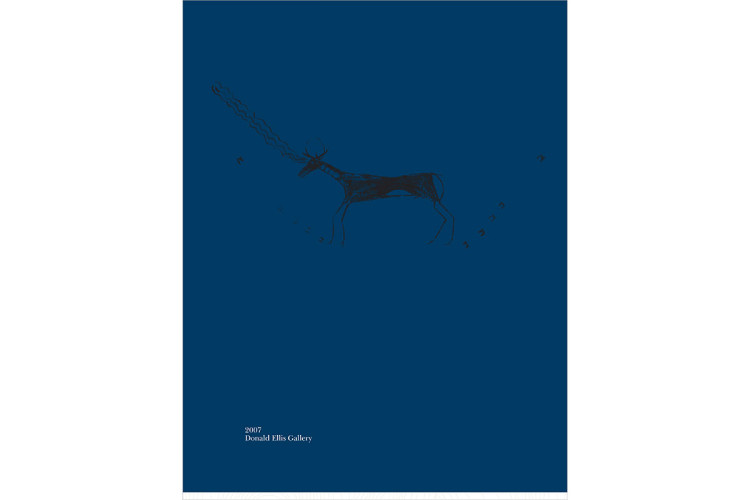
Yup’ik Masks Transform into Surrealist Art
Mary Ann Caws of the Brooklyn Rail argues that Moon Dancers: Yup’ik Masks and The Surrealists elucidates ‘the transformations from the mask to the sculptures, drawings, and paintings’
ca. 1890–1910
wood, white, red and black paint, vegetal fiber
height: 20 ½"
Inventory # E3402
Sold
acquired by the Diker Collection, now at The Metropolitan Museum of Art, NY
Collected by Ralph and Anna Sullivan, schoolteachers stationed in Hoopers Bay and Pilot Station, Alaska, between 1916 and 1920. The Sullivans collected a group of complex Yup’ik masks during their stay in Alaska, now mostly residing in the Glenbow Museum, Calgary, AB
by descent through the family
Seattle Art Museum, “Indigenous Beauty: Masterworks of American Indian Art From The Charles and Valerie Diker Collection, February 12–May 17, 2015
Amon Carter Museum, “Indigenous Beauty: Masterworks of American Indian Art From The Charles and Valerie Diker Collection, July 5–September 13, 2015
Donald Ellis Gallery catalogue, 2007, pgs. 18-19
Indigenous Beauty: Masterworks of American Indian Art From the Diker Collection, Penney et al, New York, Skira Rizzoli Pubications Inc., 2015, pg. 76
Musee Quai Branly, Paris – See: Geoffroy-Schneiter, Berenice. Primal Arts: Native Indians, Eskimo, Aborigines. New York: Assouline Publishing, 2006, cover (for a mask with divided countenance (formerly in the collection of Andre Breton)
National Museum of the American Indian, No.12/910 – See: Fienup-Riordan, Ann. The Living Tradition of Yup'ik Masks. Seattle: University of Washington Press, 1996, pg. 270 (for the mate of the above-referenced mask formerly in the collection of Andre Breton) - Note also Fienup-Riordan, pg. 270, mask second from right top, displaying similar style, possibly by the same maker
Ager Wallen, Lynn. The Face of Dance: Yup’ik Eskimo Masks From Alaska. Calgary: The Glenbow Museum,1990, pls. I - X
Complex dance masks of the Yup’ik speaking people of Southwestern Alaska are among the most extraordinary objects extant. Imaginative beyond ordinary belief, and with a style of execution that emphasizes spontaneity and originality, Yup’ik masks have captivated viewers world wide, most famously the Surrealists of the mid 20th century.
Yup’ik dance masks were used in ritualized dance performances helping to communicate between the spirit world and the world of animals and humans. Some were used to appease and attract the spirit of game animals, while others were used to supplicate malevolent spirits capable of inflicting sickness and harm upon the living.
In the important mask illustrated here, we see a bentwood hoop, said to signify the outer universe, surrounding a central face partly obscured by a salmon-like fish, a seal with a humanoid face and the neck and head of a sea bird.
The most intriguing aspect of this mask is the highly unusual handling of a frequently seen symbol in Yup’ik masks, the image of a human hand. Ritual and belief surrounding the human hand in Yup’ik cosmology is prevalent. It has been noted that: “...people might paint their hands...or rub them with dirt or soot to undertake certain actions [which] enabled them to act as a conduit, literally reaching between worlds” (see: Fienup-Riordan 1996, pg. 186). Carvers were known to rub their apprentices’ hands with wood worms in hopes of enhancing their abilities (see: Ibid, pg. 191). The hand also acted as an extension of the human body linking the human and the supernatural worlds. Many Yup’ik masks feature human hands in a flat, symbolic form, often missing the thumb and displaying a circular hole in the palm. This is widely believed to relate to the pursuit of game, the missing thumbs preventing the intermediary from blocking the passage of bounty from the spirit world, and the holes the opening through which the animals travel to earth.
In this astonishing representation, the entire mask image appears to be held within the palm of a large hand. Four realistically carved fingers surround one side of the mask grasping the fish, while a thumb protrudes over the top. In no other complex Yup’ik mask presently known can we find the hand portrayed in this stark, realistic fashion. While we may never know the artist’s intent, the viewer is left in awe of the imaginative expression contained in this remarkable Yup’ik mask.

Mary Ann Caws of the Brooklyn Rail argues that Moon Dancers: Yup’ik Masks and The Surrealists elucidates ‘the transformations from the mask to the sculptures, drawings, and paintings’

$35.00 USD